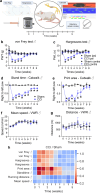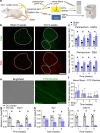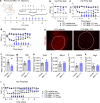TAM receptors mediate the Fpr2-driven pain resolution and fibrinolysis after nerve injury
- PMID: 39680199
- PMCID: PMC11649718
- DOI: 10.1007/s00401-024-02840-9
TAM receptors mediate the Fpr2-driven pain resolution and fibrinolysis after nerve injury
Abstract
Nerve injury causes neuropathic pain and multilevel nerve barrier disruption. Nerve barriers consist of perineurial, endothelial and myelin barriers. So far, it is unclear whether resealing nerve barriers fosters pain resolution and recovery. To this end, we analysed the nerve barrier property portfolio, pain behaviour battery and lipidomics for precursors of specialized pro-resolving meditators (SPMs) and their receptors in chronic constriction injury of the rat sciatic nerve to identify targets for pain resolution by resealing the selected nerve barriers. Of the three nerve barriers-perineurium, capillaries and myelin-only capillary tightness specifically against larger molecules, such as fibrinogen, recuperated with pain resolution. Fibrinogen immunoreactivity was elevated in rats not only at the time of neuropathic pain but also in nerve biopsies from patients with (but not without) painful polyneuropathy, indicating that sealing of the vascular barrier might be a novel approach in pain treatment. Hydroxyeicosatetraenoic acid (15R-HETE), a precursor of aspirin-triggered lipoxin A4, was specifically upregulated at the beginning of pain resolution. Repeated local application of resolvin D1-laden nanoparticles or Fpr2 agonists sex-independently resulted in accelerated pain resolution and fibrinogen removal. Clearing macrophages (Cd206) were boosted and fibrinolytic pathways (Plat) were induced, while inflammation (Tnfα) and inflammasomes (Nlrp3) were unaffected by this treatment. Blocking TAM receptors (Tyro3, Axl and Mer) and tyrosine kinase receptors linking haemostasis and inflammation completely inhibited all the effects. In summary, nanoparticles can be used as transporters for fleeting lipids, such as SPMs, and therefore expand the array of possible therapeutic agents. Thus, the Fpr2-Cd206-TAM receptor axis may be a suitable target for strengthening the capillary barrier, removing endoneurial fibrinogen and boosting pain resolution in patients with chronic neuropathic pain.
Keywords: Blood–nerve barrier; Chronic constriction injury; Fibrinogen; Nanoparticles; Pain resolution; Resolvin D1; TAM receptors.
© 2024. The Author(s).
Conflict of interest statement
Declarations. Conflict of interest: The authors have no conflicting financial interests.
Figures








References
-
- Akassoglou K, Yu W-M, Akpinar P, Strickland S (2002) Fibrin inhibits peripheral nerve remyelination by regulating schwann cell differentiation. Neuron 33:861–875. 10.1016/S0896-6273(02)00617-7 - PubMed
-
- Avanzi GC, Gallicchio M, Bottarel F, Gammaitoni L, Cavalloni G, Buonfiglio D et al (1998) GAS6 inhibits granulocyte adhesion to endothelial cells. Blood 91:2334–2340. 10.1182/blood.V91.7.2334 - PubMed
Publication types
MeSH terms
Substances
Grants and funding
LinkOut - more resources
Full Text Sources
Research Materials
Miscellaneous

